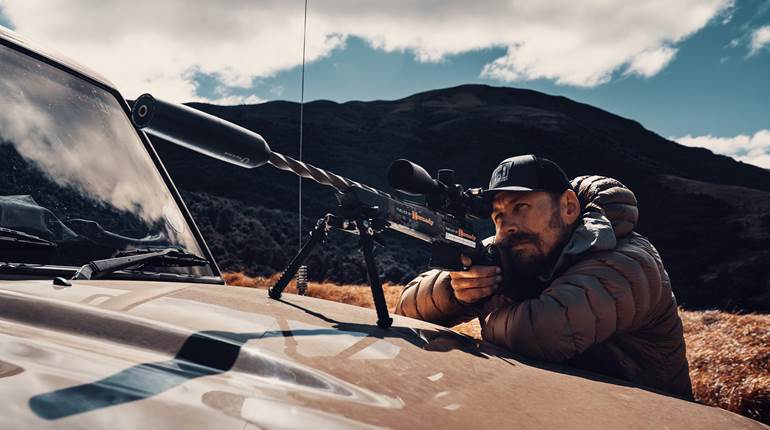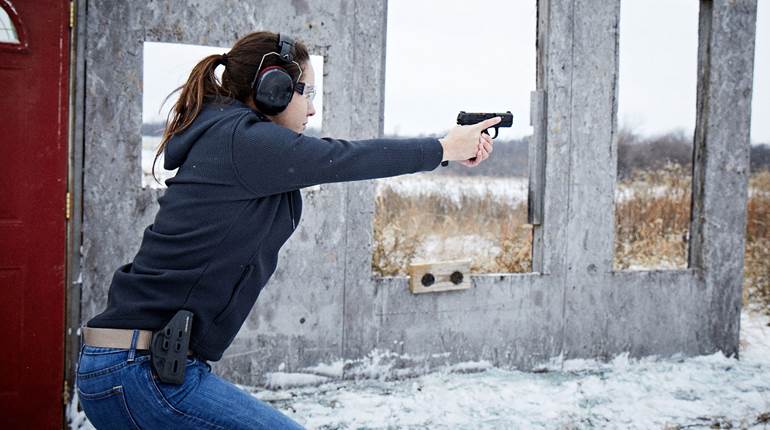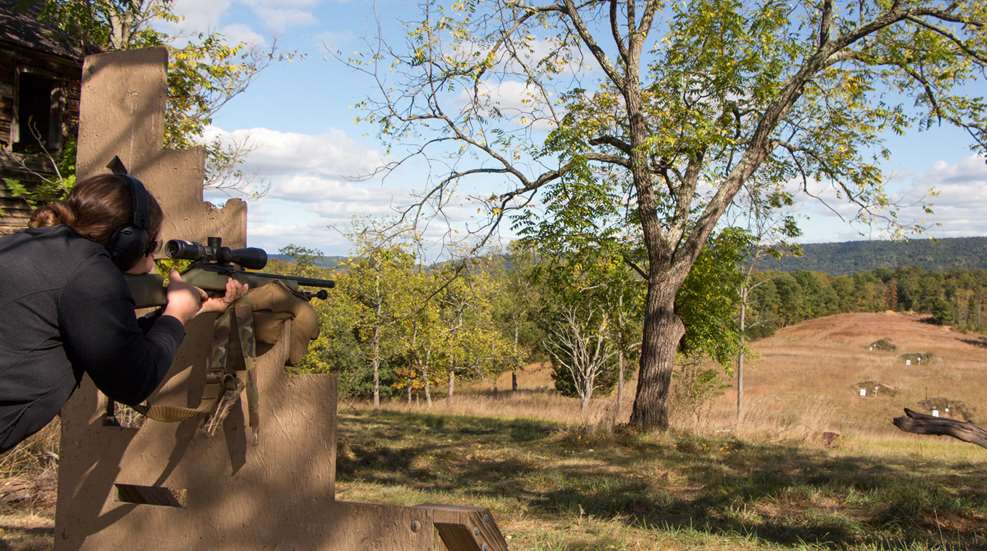
Precision rimfire competition affords shooters such as the young lady seen here an opportunity to participate in dynamic courses of fire. This barricade stage has the shooter engaging five target banks, at various distances out to 300 yards, from five barrier positions while under time constraints.
“Long range” and .22 Long Rifle are not things most shooters associate with each other. When we think of competition events for .22 LR, we envision Olympic biathlon competitors demonstrating immense marksmanship skill between bouts of cross-country skiing by shooting targets as small as 1.8" wide placed 50 meters away. Or we imagine fun afternoons plinking away at the range while teaching a novice how to shoot. With a notable nod to smallbore silhouette matches going up to 100 meters, I suspect that most people think of .22 Long Rifle as a 50-meter cartridge at best.
But in the world of long-range precision rimfire competition, 50 meters is just the starting point. Targets regularly appear at 200, 300 and even 500 meters. While these distances are distinctly “mid-range” for larger centerfire cartridges, the challenge of hitting them with a .22 LR is both exhilarating and infuriating at the same time.
It’s that challenge that makes long-range rimfire matches so fun and rewarding. If you’ve ever considered checking out an NRL 22, PRS Rimfire or even just a local club match, then allow me to heartily encourage you to get out there and to provide a few pointers to get you started on your way.
What’s The Point?
Since 1887, the .22 Long Rifle has had a long and storied history as a versatile cartridge. It’s inexpensive, has miniscule recoil and is just plain fun. The .22 LR is single-handedly responsible for hooking many shooters into a lifelong pursuit.
As a training tool, the little rimfire cartridge is difficult to beat. Many people use a .22 LR conversion kit with their handguns and semi-automatic rifles to reduce the cost of practice sessions while retaining familiarity with the gun’s ergonomics and manual of arms. Lesser known is what happens when you start stretching the legs of the cartridge to longer distances. The cartridge’s limited ballistic capability means it suffers the effects of gravity and wind at much shorter distances than its centerfire cousins. The predictable nature of ballistics makes for an interesting tool for simulating very-long-range shooting.
Compare the two ballistic tables below. On the left is a 40-grain .22 Long Rifle target load launched at 1,050 feet per second (f.p.s.) with a scope zeroed for 25 yards. The right column is for a 168-grain .30-cal. bullet fired at 2,560 f.p.s. with a rifle zeroed for 100 yards. I’m showing the drop values in milliradians (mils), popular among precision rifle competitors.
From the table, notice that shooting a .22 LR at a distance of 225 yards requires the same amount of elevation correction as shooting a .308 Win. at 850 yards. The wind holds are similar as well. In practice, this means that as long as the goal is hitting the target (not necessarily causing significant damage), then a .22 LR rifle offers a lot of training value as a stand-in for larger cartridges.
You could easily learn to run the turrets on your scope, perform holds and build improvised positions all without access to very long distances. Not to mention the cost savings of shooting .22 LR ammunition rather than quality centerfire match cartridges. In a competition setting, it also means that you require far less distance to experience a similar “long-range” shooting challenge, and match directors can create some very challenging stages with less land required.
Now don’t get me wrong, the .22 Long Rifle is not a perfect substitute because of its near-total lack of recoil. For example, you can get away with some improvised shooting positions with a rimfire that you would never be able to do with a larger rifle without getting a nasty case of scope bite or losing control of the rifle entirely.
Despite this shortcoming, participating in a long-range rimfire match is an incredibly fun time, and you will learn a lot about the ins and outs of precision shooting. Of course, one of the biggest barriers to entry is knowing where to start with equipment.
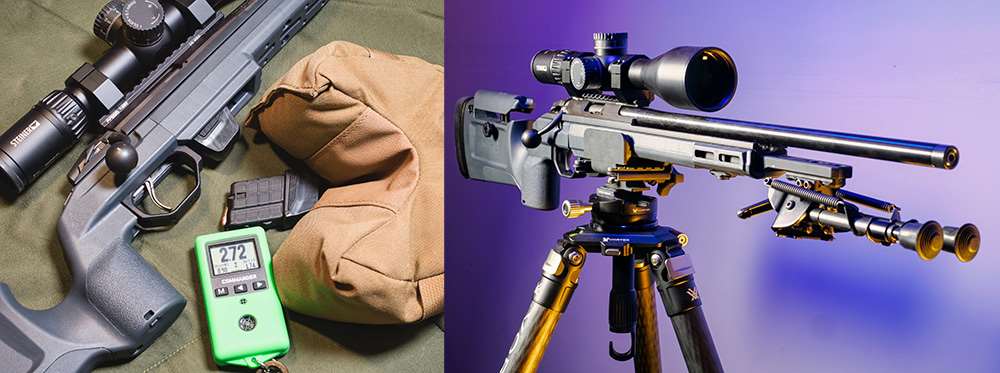
Rifle & Optic
The most important part of this whole thing is having fun, and you don’t need very much equipment to do that. However, you also don’t want your equipment to hold you back. Luckily, precision rifle competitors are some of the friendliest people around and are perfectly willing to let you borrow just about anything—except their rifle.
When you arrive at your first precision rifle match, you only need a few key things on top of your standard array of safety equipment like ballistic glasses, ear protection and chamber flags. We’ll start with the rifle and optic, the most important parts of the equation, and then work outward to the additional equipment that you’ll find to be useful.
Rimfire rifles used in long-range matches run the gamut from affordable, entry-level rifles to complete custom-built guns rivaling the cost of their full-power counterparts. For the vast majority of people getting started, something on the budget-friendly end does just fine. The high-end rifles do have several advantages, but they don’t become important until you’re comparing two very skilled shooters vying for the top position. For beginners, there’s a long way to go and a quality factory rifle meets those needs.
In no particular order, the most popular entry-level factory bolt-action rifles encountered in competition are the Tikka T1x, CZ 457 and Bergara B-14R. The base models work well, but each of these manufacturers also have upgraded versions designed for competition. For semi-automatic rifles, the Bergara BXR, Ruger 10/22 and Savage A22 are all popular options. Whatever the gun, you’ll want it to be capable of holding about 1 minute of angle (m.o.a.) or better precision. You might have guessed that there are divisions for both bolt-actions and semi-automatics, but you’ll find most people run bolt guns. The reason for this is that there’s a lower chance of a bolt-action suffering a malfunction with subsonic ammunition as the rifle gets dirty.
Why would you want a subsonic bullet? The transonic zone, where a bullet slows from supersonic to subsonic speed, induces significant instability during bullet flight and negatively affects consistency from shot to shot. Typical supersonic rimfire loads designed for varmint hunting hit this transonic zone at around 50 yards, so it’s less of a concern at short ranges. But when you need to hit a target at 200 or 300 yards, consistency matters a lot. Subsonic bullets, while slower, are more predictable and therefore more desirable in a precision rifle match.
Don’t feel pressure to immediately modify the rifle with a new chassis system or anything out of the gate. It can help tighten groups and aid in ergonomics, but if you’re working within a budget, then your best bet is to save the money on a chassis and put it toward your optic instead.
Perhaps more important than your choice of rifle is the choice of optic to pair with it. Rimfire match targets are often small, and you need to be able to locate them against the background. You might think that a precision rifle automatically calls for a high-magnification scope that tops out in the 25-30X range, but you’d be mistaken. High magnification makes it more difficult to locate and track targets as you transition between them; it makes scope jitter very apparent when using improvised shooting positions and generally slows you down.

Most precision rifle competitors are happy keeping their scopes set between 10X and 16X for the entire match for the greater field of view. With that in mind, scopes in the 3-15X, 4-16X, 5-20X or 5-25X range are all satisfactory. As an additional criteria for rimfire rifles in particular, look for a scope that adjusts parallax down to 15 or 25 yards.
Since a precision rifle match has you cranking up and down on the turrets throughout nearly every stage, you need your turrets to be accurate and repeatable. This is where a little extra budget toward the optic goes a long way. When you need to dial 14.7 mils of elevation for one target, then adjust to 3.5 for another, then return to zero, you need it to be dead-on every time.
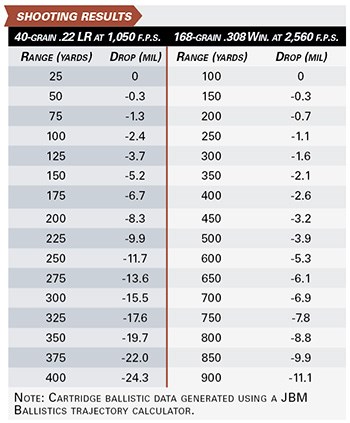 I prefer scopes with reticles in the first focal plane for competition use. That means the reticle grows and shrinks as you move through the magnification range. This allows for accurate holdovers with the reticle, regardless of the magnification setting.
I prefer scopes with reticles in the first focal plane for competition use. That means the reticle grows and shrinks as you move through the magnification range. This allows for accurate holdovers with the reticle, regardless of the magnification setting.
Adjustments in either minutes of angle (m.o.a.) or milliradians (mils) work well. Most competitive shooters use milliradian rifle scopes and spotters. Since it’s helpful to use the same system as everyone else for communication’s sake, I suggest going the milliradian route. Whichever way you go, make sure that the scope turrets and reticle use the same system—you don’t want to lose time by performing mental math converting between the two measurements.
Support Equipment
The most important things you need at your first match is a properly zeroed rifle and solid ballistic data—particularly the velocity and ballistic coefficient of the bullet. You can borrow almost anything else from other shooters if you need it. When you’re ready to pick up some extra items, then the most important ones to consider are a shooting bag, bipod, sling and a way to track your dope for each stage.
There are a variety of shooting bags on the market, with two of the most popular being the Game Changer from Armageddon Gear and WieBad’s DRC Fortune Cookie. The shooting bag serves many purposes, but the most important is as an intermediate platform for stabilizing the rifle on hard objects with improvised shooting positions.
Why not a bipod first? Bipods obviously help support the rifle when shooting from a flat surface. In my experience, though, you aren’t going to have many opportunities to do that in a match. When you do, then you might be just as well served by the shooting bag as you would a bipod. For that reason, I think the shooting bag is the more important purchase up front, while the bipod is a nice-to-have.
Shooting slings have a long history in competition marksmanship, and that’s no different in precision rimfire. Companies like TAB Gear, Armageddon Gear, Short Action Precision and Rifles Only all produce high-quality shooting slings. I prefer a sling to be 1.5" wide and have a fast-adjustment mechanism to help transition from position to position. You don’t always need it, but when you do, then you’ll be glad you have it.
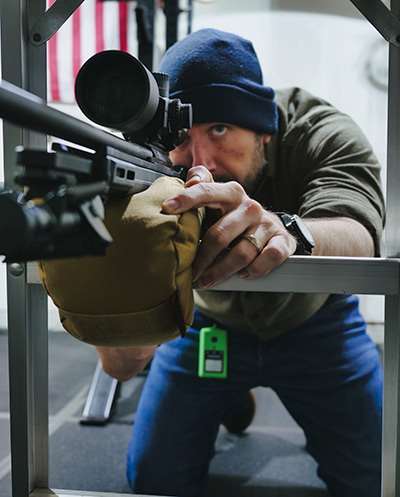
Lastly, you need a way to track your sight adjustments. The distance to each target is part of the stage briefing, so that means you also have time to figure out your dope ahead of time. This does not need to be fancy, and a piece of masking tape slapped on the side of the stock works well. Write down the adjustments, stick it on the rifle, shoot the stage and then replace it for the next stage. A free ballistic calculator application on your phone provides you all the data you need to get set up—as long as you have good ballistic data to start with. I cannot emphasize enough that you need to have a solid zero, cartridge ballistic data and velocity.
One more thing: plan for a way to keep spare magazines handy. At my first match, I spent too much time fishing around inside my pockets to grab a spare magazine. It seemed OK when standing, but didn’t work as well while sitting or kneeling.
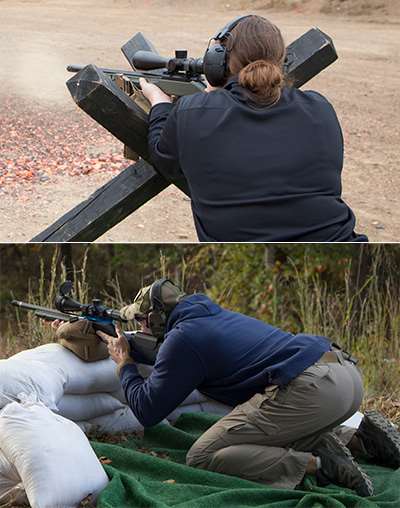
Training For The Match
A precision rimfire match, like its centerfire counterpart, bases scores on time and hits. There are not necessarily scoring “zones” on targets; you either hit it or you don’t. For any given stage, you either hit all of the targets within the allocated time with the allowed number of shots or you don’t. Even better if you hit those shots faster than everyone else.
The challenging part about a long-range rimfire match is not figuring out how you’re going to work out the ballistics for each target to hit it—assuming you have good ballistic data and a properly zeroed rifle, the math takes care of you. Instead, the real challenge is quickly building a stable enough shooting position in awkward spaces.
Whether it’s crammed into the driver’s seat of an old truck or balancing on a suspended platform, your ability to build a stable position and execute the fundamentals of marksmanship is the crux of the event. To that end, the best way to train at home is not by endlessly dry-firing at small targets from steady positions. Mastering these basics are definitely important, but it’s only a part of the picture. Instead, spend most of your time practicing quickly building a shooting position and “firing” an accurate first shot.
One of the easiest tools for doing this at home is a ladder. Start from a low-ready standing position with your rifle (obviously made safe for dry-fire) and then start a timer. Start with the lowest rung of the ladder, build your position with a shooting bag and take a “shot” at a small target on the opposite wall. Break the position and rebuild it on the next rung up and fire again. Keep going and repeat it for as many rungs as you like. Practice going up, down, and even use the slanted legs of the ladder itself. With every session, try to lower the time it takes to make an accurate shot.
Don’t neglect your standing position! Most stages involve some form of support, but every once in a while you’ll come across a standing-only stage, and most people don’t practice enough for it. My friend and law-enforcement sniper instructor, John Simpson, pointed out to me that time spent practicing shooting while standing is never wasted. Every improvement in precision made from the standing position directly translates to improvements in supported positions.

Now Go Compete!
One of the greatest hazards of the shooting world is the impulse to continue researching and optimizing rather than getting out and actually doing. You will probably not rank very high in your first several matches, and that’s OK. The most important part is that you have a solid baseline of reliable equipment and a steady practice regimen feeding from the lessons you learned in competition. With those two things alone, you’ll be set up for a lot of future success.
Even if you’re not in it to win it, there’s a lot of great times and friends to make at your local match. You’ll learn far more from the other competitors than I could ever fit into a few pages. Good luck, and have fun!













